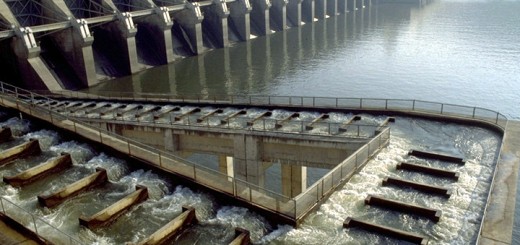Impact of a dam removal on fish habitat
Dams can have a negative impact on fish habitat by altering fish passage and spawning sites. Compared to large high-profile dam removal, small run-of-river dam removals in small upland catchment areas are not well studied and monitored. Depending on the sediment composition and grain size, different dam removal events can have different effects on fish habitat. So far, more than 1100 dams have been removed nationwide over the past three decades as a step towards river restoration. However, there is a need to monitor pre and post removal affects to understand the magnitude, rate and sequence of geomorphic and/or ecological recovery of dam removal.

Fig. 1 View of Pelham dam pre- and post-removal. View in (A) is from below the dam on river left looking upstream. Note the level of sediment fill up to the dam crest. View in (B) is fromriver left to river right. Note the reconnected sediment flux through the former dam site (Magilligan et al., 2016).
Magilligan and co-authors studied immediate impacts of a small-scale dam removal in central Massachusetts to identify the eco-geomorphic response. On November, 2012, an old (~190 year-old) 6-m high, run-of-river industrial dam on Amethyst Brook (26 km2) was removed. Authors collected data on sediment composition and fish abundance both immediately before and after the removal, (Fig.1 A and B). Authors collected data from cross sections, detailed channel bed longitudinal profiles, embeddedness surveys, and channel bed grain measurements at both upstream (~300 m) and downstream (>750 m) of the dam to collect baseline data at multiple scale. A detailed electrofishing survey was carried out to assess stream fish richness and abundance above and below the dam site and throughout the watershed. A visual nest site survey of native anadromous Sea lamprey (Petromyzon marinus) was also carried out. Two natural events occurring alongside this dam removal were the removal of an old wooden crib dam (Fig. 2) and a large flood within the first year of removal, which have potential effects on overall restoration dynamics.

Fig. 2 Exhumed wooden crib dam. Photo taken soon following the 28 June 2013 flood (Magilligan et al., 2016).
With immediate post dam removal survey Magilligan and co-authors documented the presence of four fish species, including sea lamprey. They also observed lamprey spawning activity immediately below the dam site. Prior to the dam removal, sea lamprey and their spawning ground were not present at that site. This indicates the connection of upstream passage.
Dam removal can limit habitat fragmentation and reconnect riparian zone to fundamental hydrological process and channel-floodplain exchanges. However, there is a rising concern about the sediment release and addition of chemicals of emerging contaminants (CECs) and other pollutants during the dam removal process, which can ultimately impact downstream geomorphic and ecological processes. This leads to the transition of research from conceptualisation of potential impacts to more field-based analysis. Potential extreme flow caused after dam removal can cause sedimentological effects, where channels become highly vulnerable to rapid and extreme adjustments that can cause interactive effects on channels and river habitats that can be difficult to anticipate. In terms of ecological effects dam removal becomes complex at temporal and spatial scales, affecting different ecosystem components. Dams and dam removal may also affect physical habitat driven by different geomorphic processes. The presence of fish species immediately after dam removal suggests the importance of interactions between dam removal and flood disturbance effects within a small river system.
Together with physico-chemical processes in the river system, sampling, monitoring and assessment time can have an important impact. As results from the work by Magilligan and co-authors indicate the importance of short and long term monitoring and assessment impacts on river system. There is a need to plan a project in relative terms of natural and physical processes occurring in the system. In natural ecosystems there are various drivers working together, which makes it further complex system. Sometimes there can be unpredicted results due to other ecosystem drivers including climate and prey, that needs particular attention.
Reference:
Magilligan, F.J., Nislow, K.H., Kynard, B.E., Hackman, A.M., 2016. Immediate changes in stream channel geomorphology, aquatic habitat and fish assemblages following dam removal in a small upland catchment. Gomorphology, 252, 158-170.



